

CarExpert.com.au
The CarExpert team's favourite cars of 2025
6 Hours Ago
The Hyundai Ioniq 5 and Lexus UX300e are similarly priced, but these two electric crossovers couldn't be more different.

News Editor
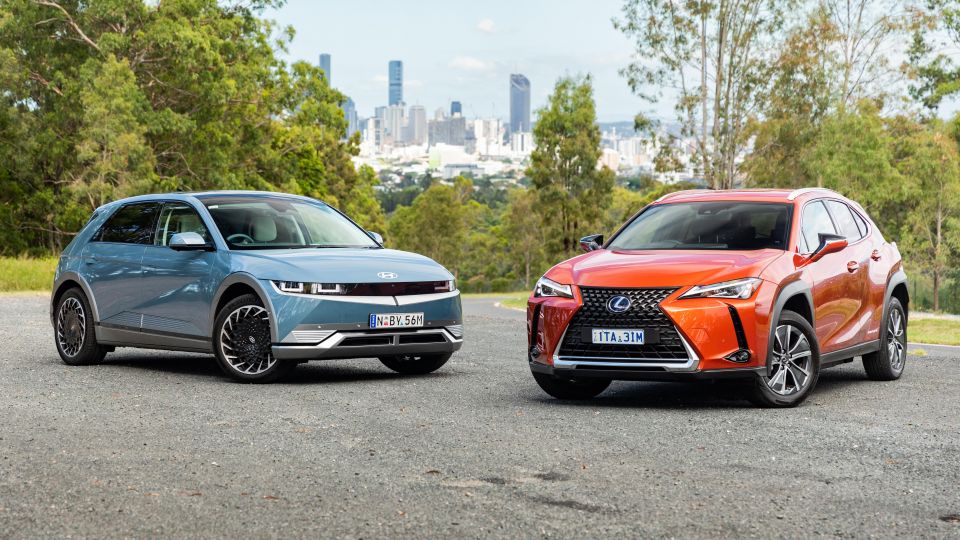

News Editor
Do Hyundai and Lexus buyers cross-shop the two brands? Traditionally it would seem unlikely, but in this case, they should.
Lexus’ first electric vehicle, the UX300e, is priced right up against the Hyundai Ioniq 5.
They’re different in a lot of ways. The UX300e is an electric version of an existing internal combustion-engine model and is smaller than the Ioniq 5 – which itself is about as clean-sheet as a car can be, riding on a dedicated electric vehicle platform.
But this isn’t like comparing a V8 Ford Mustang to a front-wheel drive Audi A5. Despite their differences, these are two similarly-priced cars that offer buyers a well-appointed interior and a long list of standard equipment for under $75,000 before on-road costs.
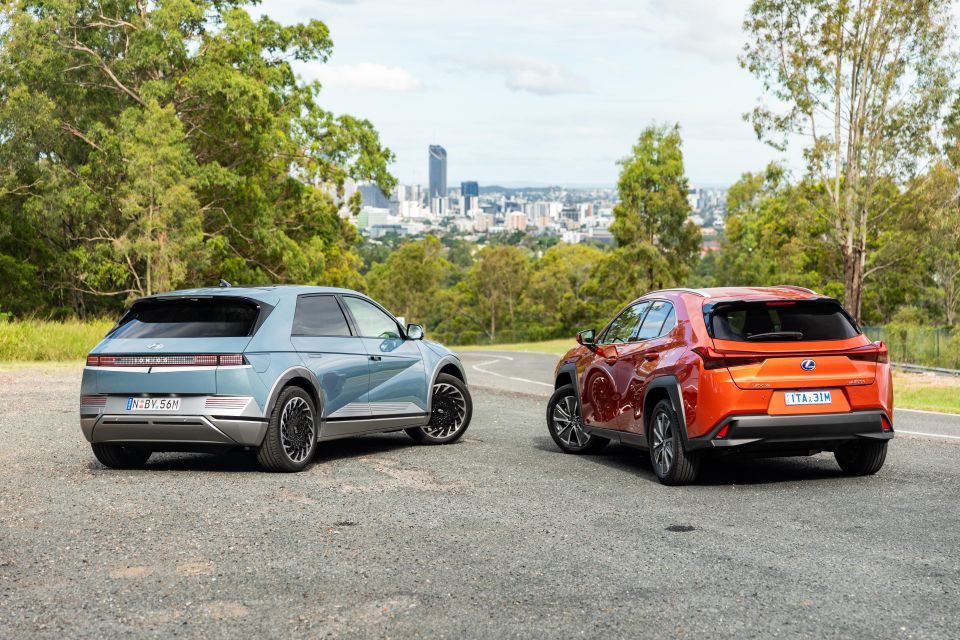
They’re both ostensibly SUVs, and neither is all-wheel drive (only the Hyundai has the option).
They also both look like hatchbacks. The Ioniq 5’s exterior is fascinating – it was inspired by the original Hyundai Pony, a small hatchback and fastback sedan, and yet its dimensions are close to that of a new Tucson with a wheelbase longer than that of a Palisade.
I’ve lost count of the number of times people have said, “I thought it was going to be a small hatchback but it’s enormous in person”. Somehow, though, it comes together nicely.
In addition to a handsome shape, the Ioniq 5’s design elements are a feast for the eyes.
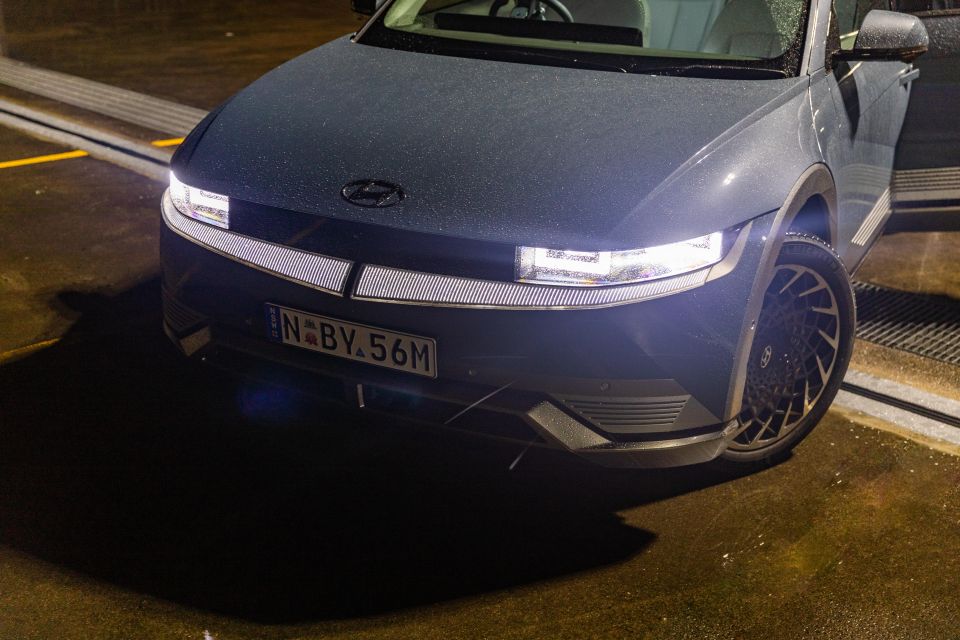
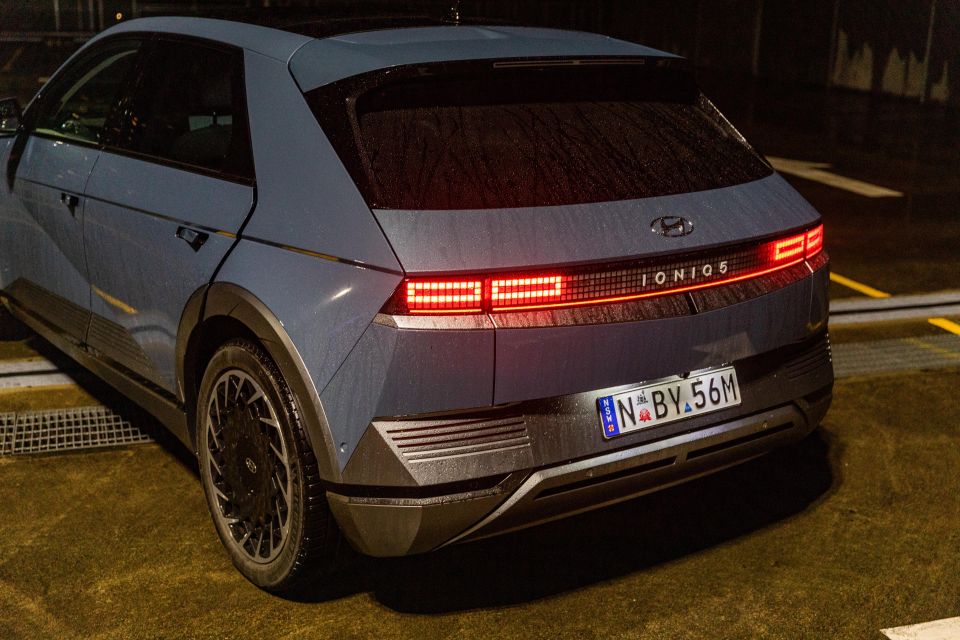
The ‘Parametric Pixels’ of the headlights and tail lights, for example, feel very ‘Tron’. The headlights in particular are fascinating to behold, with two squared-off U-shaped elements in each assembly that also function as the indicators.
Then there’s the metallic trim underneath them that’s illuminated at night, the distinctive grooved brightwork on every side of the vehicle, the flush door handles, and the cleverly integrated rear spoiler.
Taste is subjective but the wheels are a little overwrought, though they look better from some angles and superior to the UX300e’s, let alone the ghastly ones on the Tesla Model 3 Standard Range.
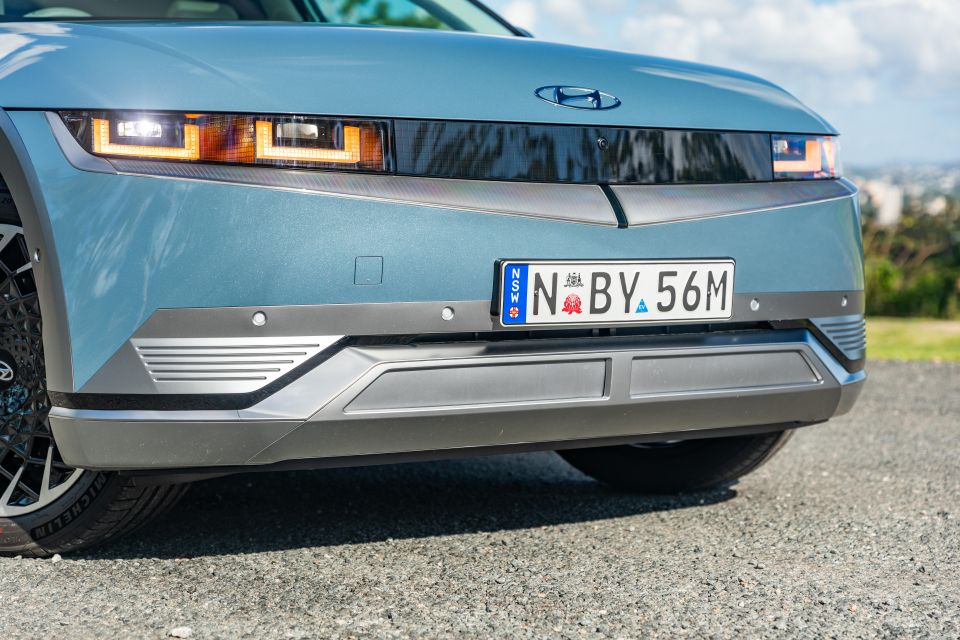
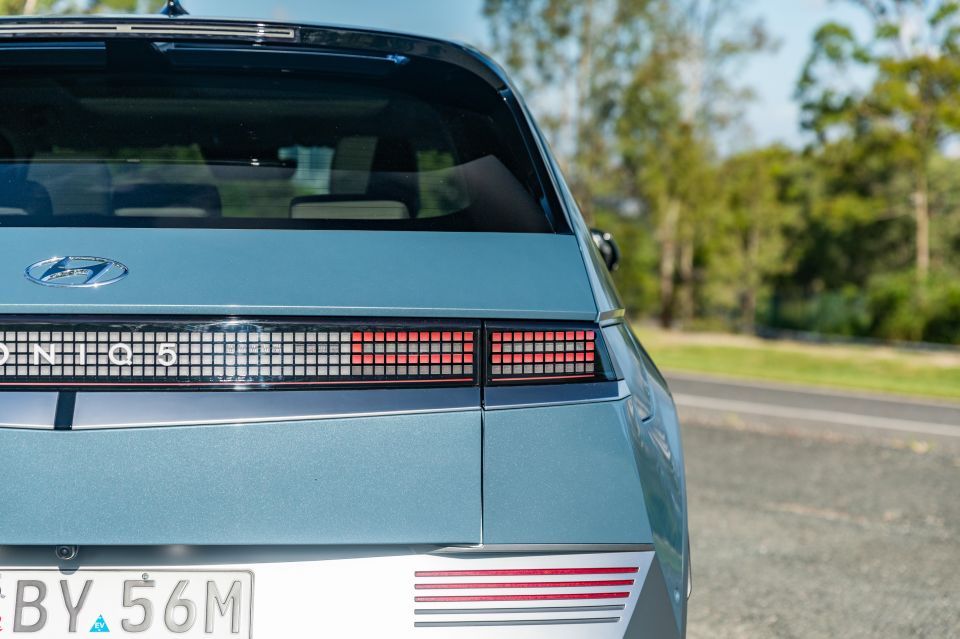
It feels like Hyundai’s designers were told to make something distinctive and special when penning the Ioniq 5, and it hasn’t been hemmed in by its homage to a past model, either. Against this creative vision, the UX300e – virtually identical to petrol and hybrid UXs externally – is naturally going to fall short.
Lexus’ current design language polarises and, while I’m usually a fan, the UX looks like a conventional small hatchback festooned with peculiar details.
The squared-off, plastic wheel arch extensions look straight off of a Toyota RAV4, while the tail light assembly juts out like the tail fin of something American from 1959.
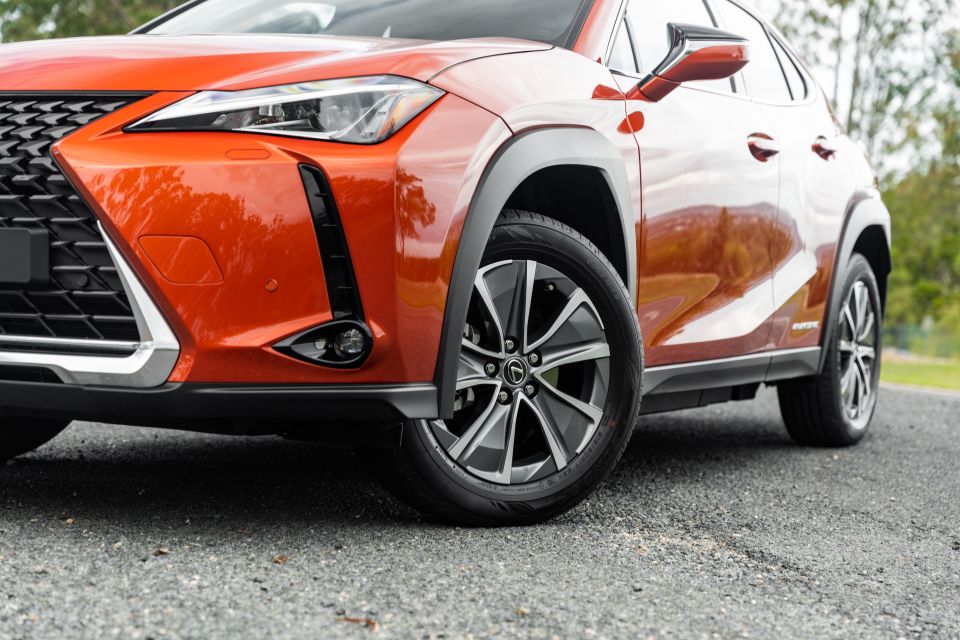
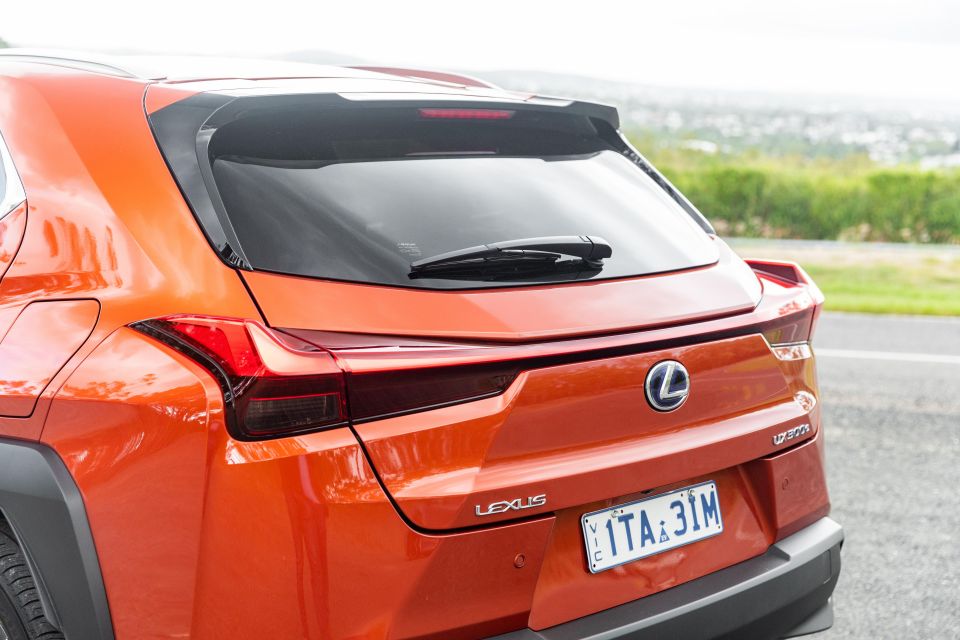
The paint has a fabulous lustre to it, especially up close. However, this particular shade of orange – called Carnelian – feels a little too mid-2000s for my tastes. It makes me understand why people buy cars in boring silver, white and black, but it’s worth noting the UX can be had in a gorgeous Celestial Blue or the intriguing Khaki Metal.
Lexus’ spindle grille is present and accounted for, and hasn’t been completely blanked-off. Its sharp lines, as well as those of the lighting assemblies plus the dramatic side creases, contrast somewhat awkwardly with what’s a curvy body overall.
Is the UX’s styling offensive? I’d argue no. But it won’t stop people in their tracks, either, in the way an Ioniq 5 will.
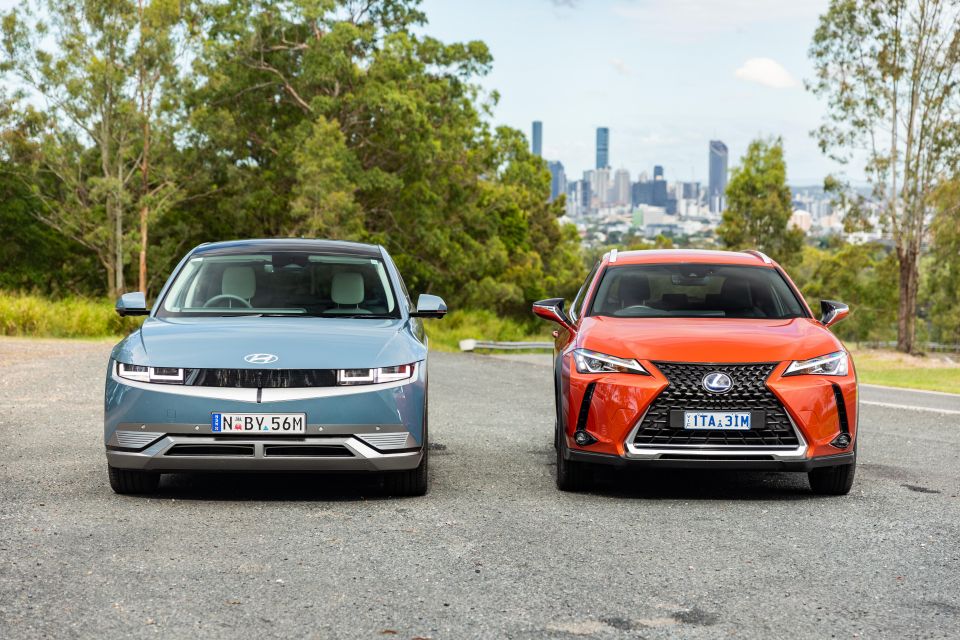
The two-model Ioniq 5 range lobbed late last year, with a fixed price of $71,900 before on-road costs for the single-motor rear-wheel drive vehicle you see here, and $75,900 before on-roads for the dual-motor all-wheel drive variant. Both have identical feature lists, powertrain aside.
Hyundai promised an allocation of 400 units but ended up importing only 240 despite over 10,000 expressions of interest. If you’re waiting for one in the next allocation, I wish you the very best of luck.
The Lexus UX300e also arrived late last year, priced at $74,000 before on-road costs in base Luxury guise, as tested, and $81,000 list for the Sports Luxury.
The cheapest UX300e is therefore around $22,000 more expensive than the most affordable UX250h front-wheel drive hybrid but it’s not quite that simple, as there are some spec differences to mitigate this.

You can’t really call either car wanting for features.
Standard equipment common to both cars includes:
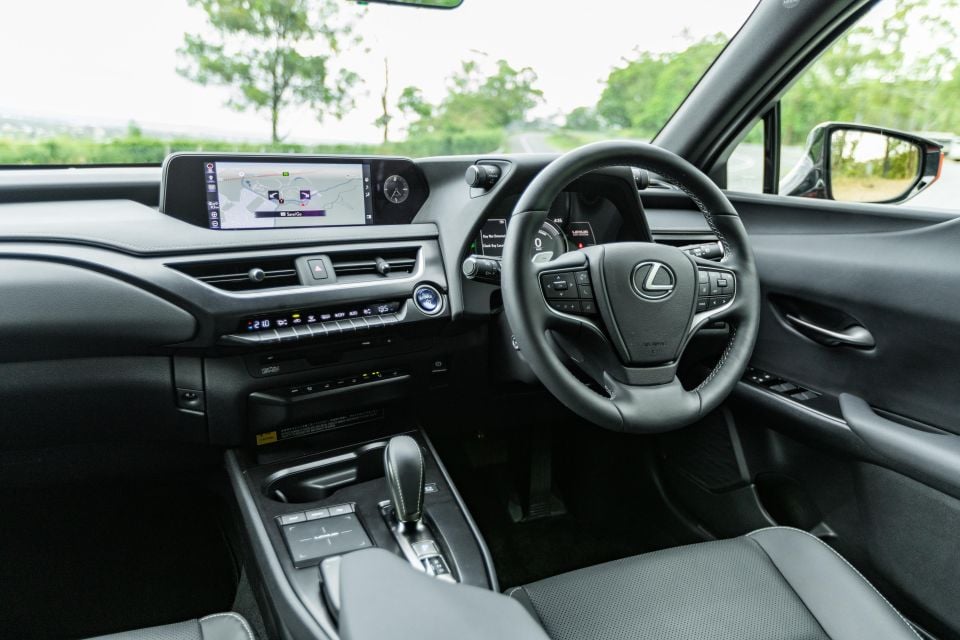

Features exclusive to the Hyundai include:
Features exclusive to the Lexus include:
If you step up to the UX300e Sports Luxury, you get a head-up display, a surround-view camera and tri-beam LED headlights with adaptive high-beam. Overall, however, the Ioniq 5 stacks up better when you compare its feature list with that of the UX300e Luxury.
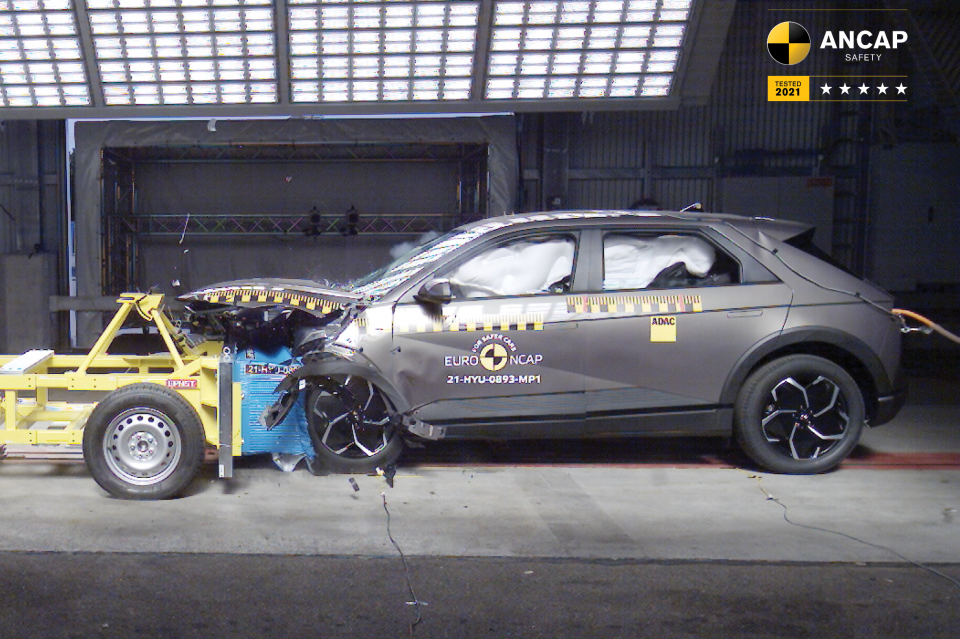

Both the UX300e and Ioniq 5 have five-star ratings from ANCAP, with the Lexus wearing a 2019 datestamp and the Hyundai wearing one from 2021.
The UX300e received an adult occupant protection rating of 96 per cent, a child occupant protection rating of 88 per cent, a vulnerable road user protection rating of 82 per cent, and a safety assist rating of 83 per cent.
The Ioniq 5 received ratings of 88 per cent, 87 per cent, 63 per cent and 89 per cent in these categories, respectively.
Standard safety equipment common to both cars includes:
The Hyundai is unique in offering a Blind-Spot View Monitor, which projects camera footage in the instrument cluster when you turn on the indicator.


The Lexus has one extra airbag for a total of eight, but the Hyundai has the edge in terms of safety equipment overall.
Instead of blind-spot monitoring and rear cross-traffic alert like in the Lexus, the Hyundai features active blind-spot assist and rear cross-traffic assist that will intervene to stop you from having a collision.
Its autonomous emergency braking system is also more sophisticated. The Lexus’ system features pedestrian and daytime cyclist detection, but the Hyundai’s features night-time cyclist detection and a junction turning feature. The Hyundai also includes lane-change oncoming and side assist.
Other features exclusive to the Hyundai include:
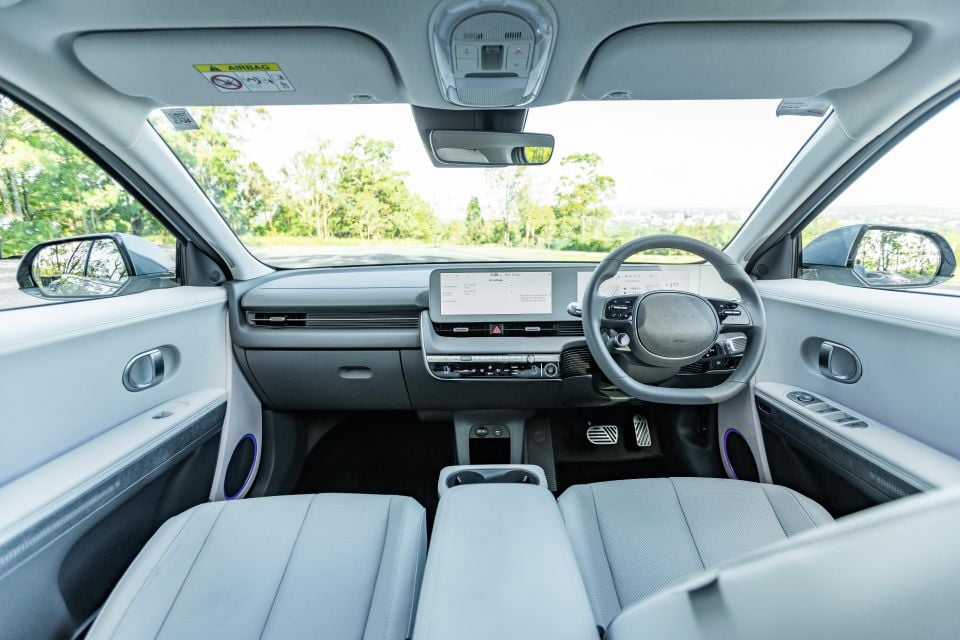
Ioniq 5
Pull the flush door handle and you’ll enter a cabin that’s at once retro and futuristic, with seats swathed in white leather upholstery and bathed in light thanks to the panoramic fixed glass roof.
Interior lighting is LED, while colour-adjustable ambient lighting glows behind the arm rests of the doors and encircles the speaker grilles. The only bizarre design element is the forward section of the front doors, which is finished in pink.
Like the exterior, the Ioniq 5’s interior is full of surprise and delight features. The glove box is actually a drawer you can slide out – why does nobody else do this? The centre console slides back and forth, allowing you to free up space. You can theoretically enter the driver’s seat from either side of the vehicle, like this is some old Falcon with a bench seat.

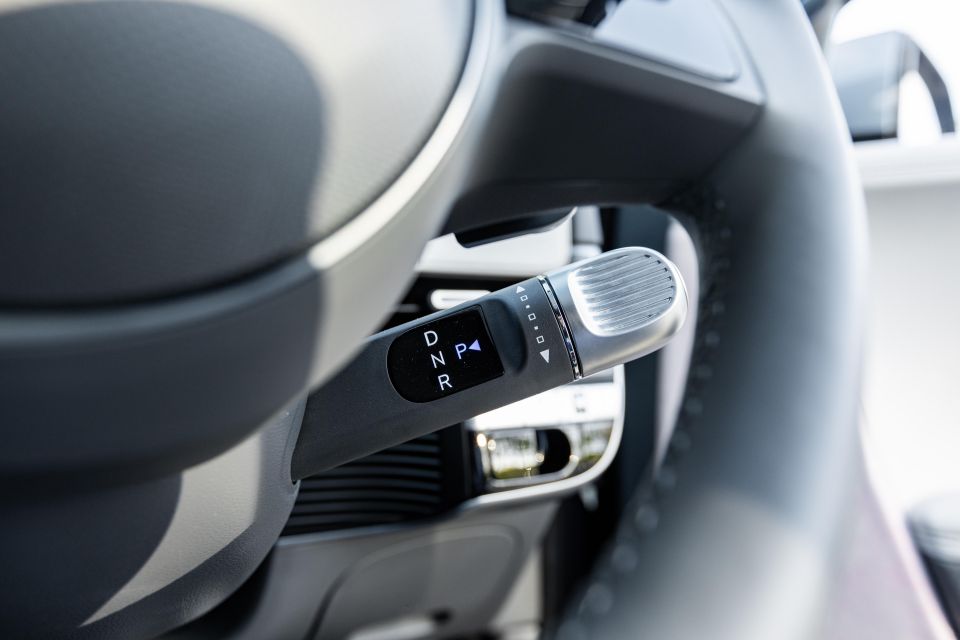
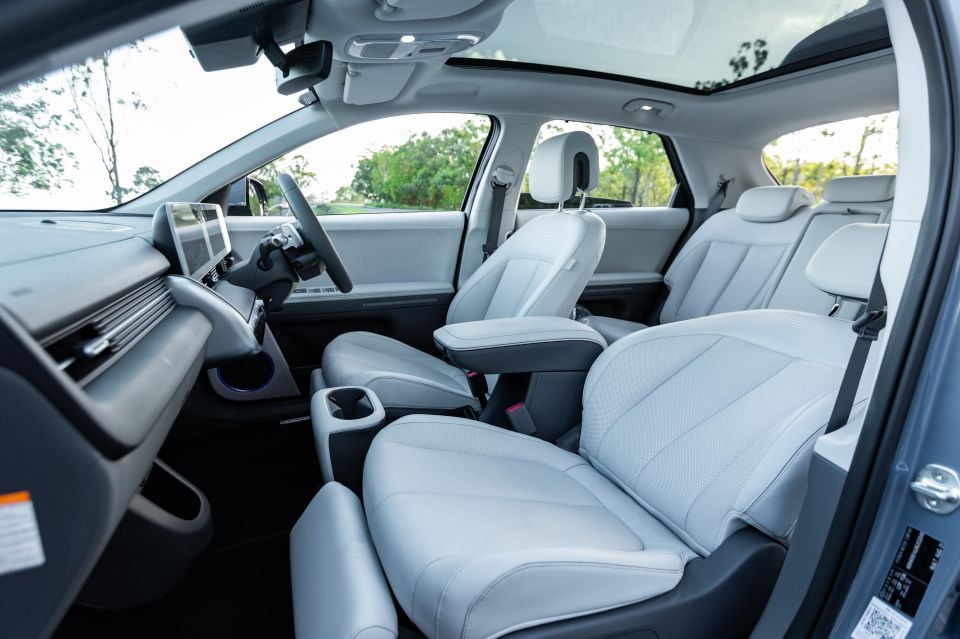
The centre armrest also features a covered storage space, handy for concealing valuables, while the centre console is where you’ll find two USB-A outlets, a wireless charging pad, and a flat, rubberised shelf. The minimalist centre stack features a storage cubby, plus another USB-A outlet and a 12V outlet.
Gear selection is done via a chunky column stalk that feels high quality. Instead of pushing it like most shifters, you twist the end to change between Drive, Neutral and Reverse. You get used to it quite quickly, and it feels more substantial than Mercedes-Benz’s shifters, so you won’t mistake it for the indicator stalk.
Though the Ioniq 5 comes from a mainstream brand, there’s no gulf in quality between it and the luxury-brand UX300e. The doors still close with a solid thunk, the switchgear feels nicely damped, and there’s roughly the same number of soft-touch surfaces in the cabin. Only an occasional rattle from the tailgate brings the score down.
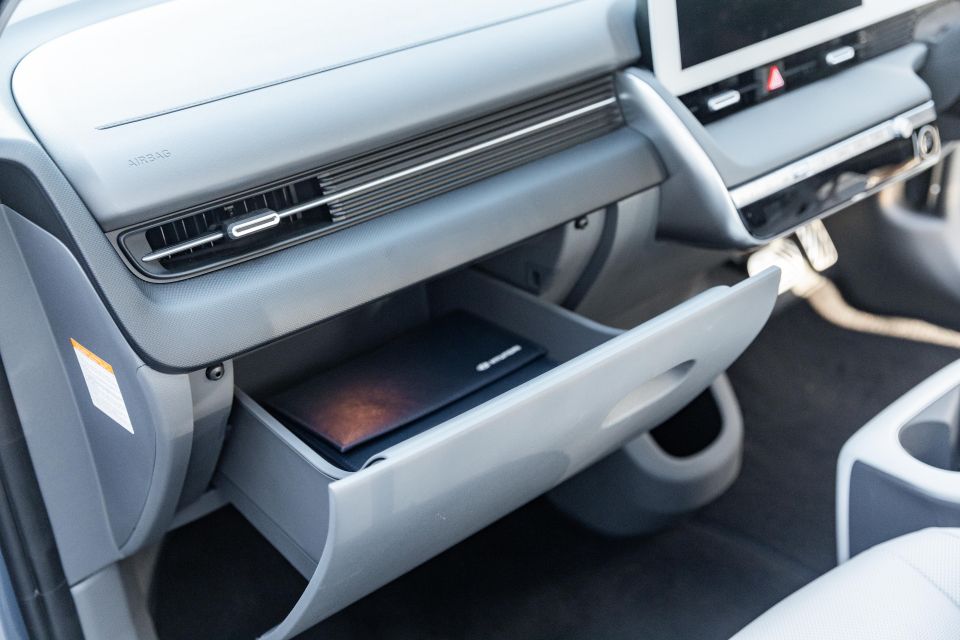
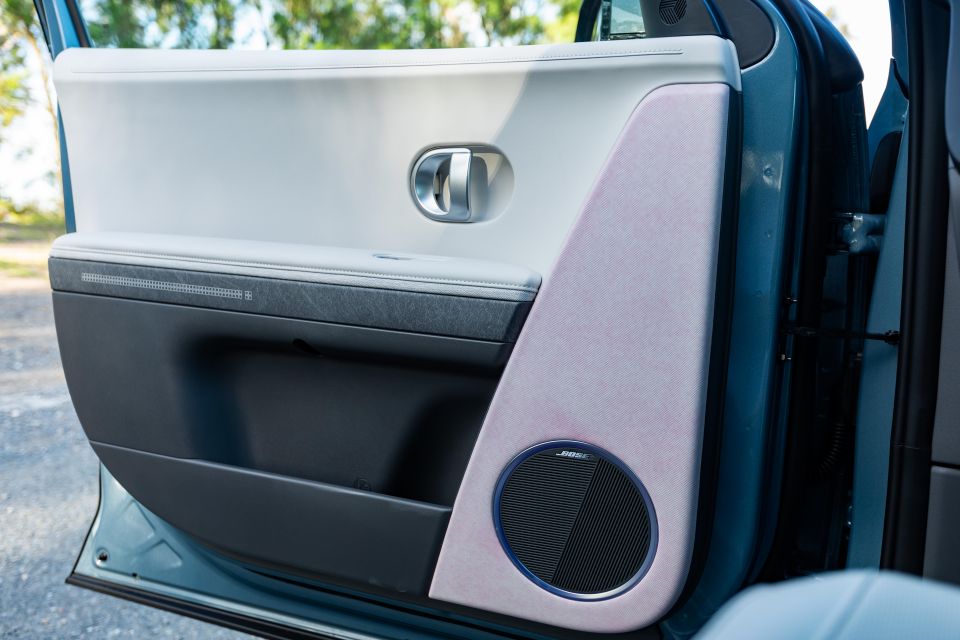
Refreshingly, there’s virtually no piano black trim in either car, though the Ioniq 5’s climate controls are touch-capacitive, gloss black items. As with other recent Hyundai models, these controls look nice but lack haptic feedback.
There are some other useability foibles with the Ioniq 5. The rectilinear dashboard looks lovely, but as the touchscreen isn’t angled towards the driver, you’ll find certain functions are a bit of a reach.
Unlike most Hyundai, Kia or Genesis products, the controls for the heated and ventilated front seats are buried in the touchscreen and are a real pain to access on the move.

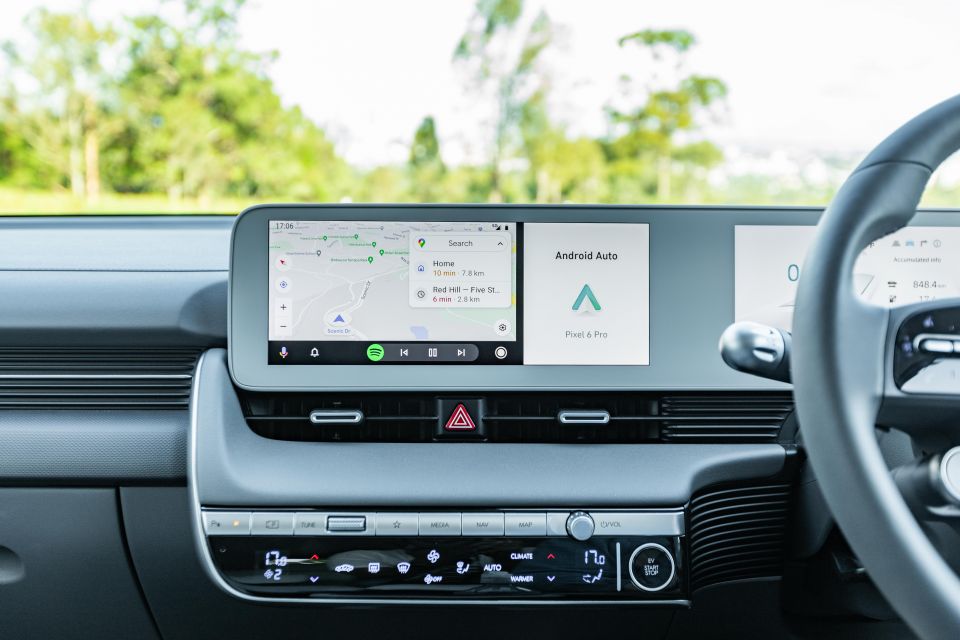

Where expert car reviews meet expert car buying – CarExpert gives you trusted advice, personalised service and real savings on your next new car.
The white user interface for the touchscreen and instrument cluster is slick and modern, though it’s little more than a skin on Hyundai’s familiar interfaces.
There’s fundamentally nothing wrong with either Hyundai’s infotainment interface or digital instrument clusters, but there’s no new functionality here besides a slick EV menu on the touchscreen. If you were expecting, for example, a map display for the instrument cluster, you’ll be disappointed.
The digital speed readout is also on the left-hand side of the screen instead of in the centre, and the head-up display available in Korea isn’t offered here. On the infotainment front, we also continue to be miffed that Android Auto doesn’t display in full-screen.
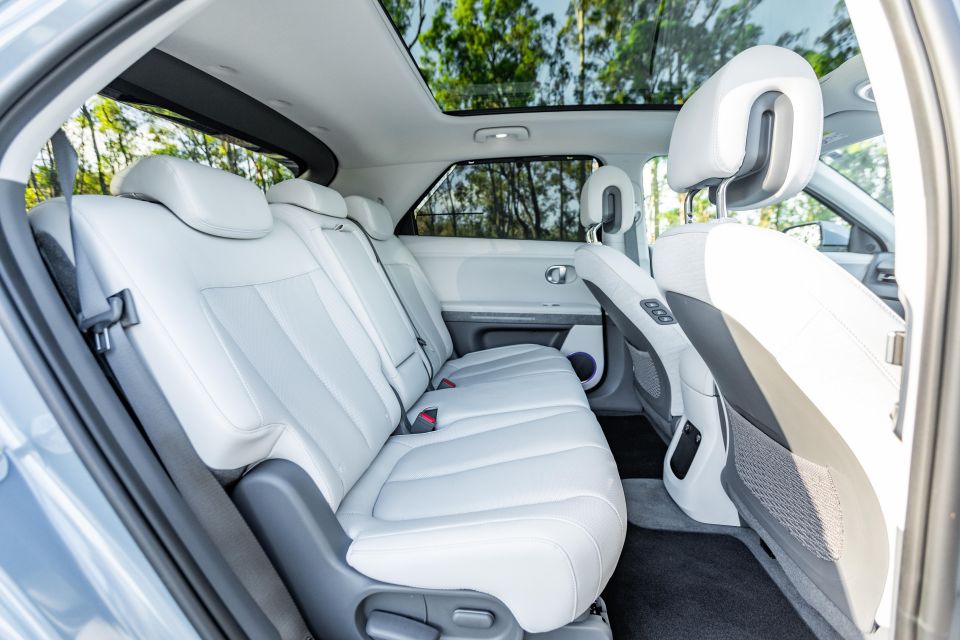

The EV menu on the touchscreen is neat and easy to navigate. It displays the nearest charging station and allows you to alter settings, including the charging limit. You can also schedule charging.
The Ioniq 5’s front seats are superb. They can be reclined almost completely flat, and they feature integrated, adjustable leg rests that provide additional calf support. That also makes the Ioniq 5 the more comfortable car to relax in while you’re waiting at a charger.
Step into the back and there’s ample legroom for someone 180cm tall sitting behind someone else of a similar height. The floor is flat, and the comfortable rear bench can be electrically reclined.
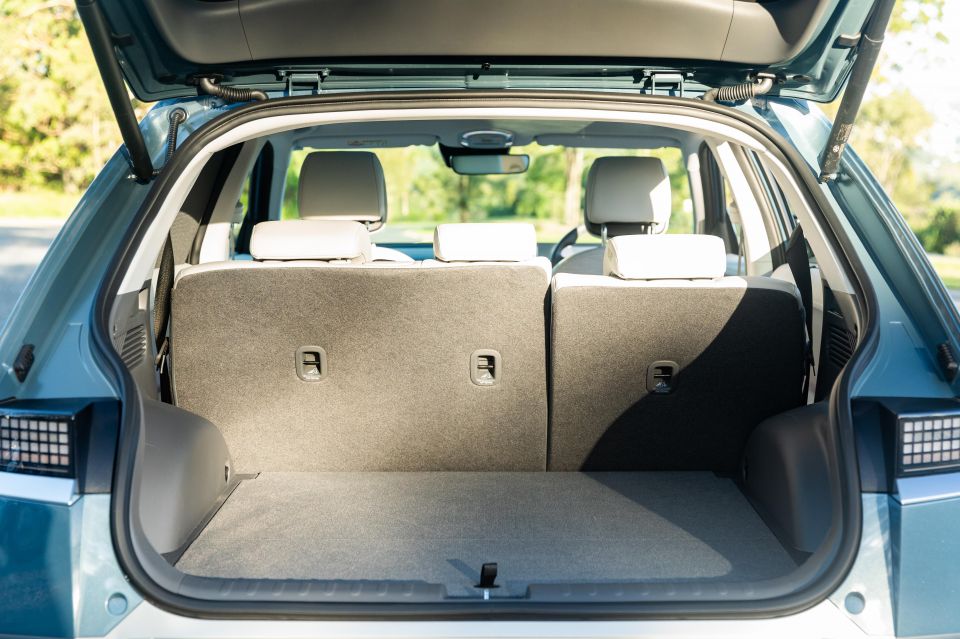
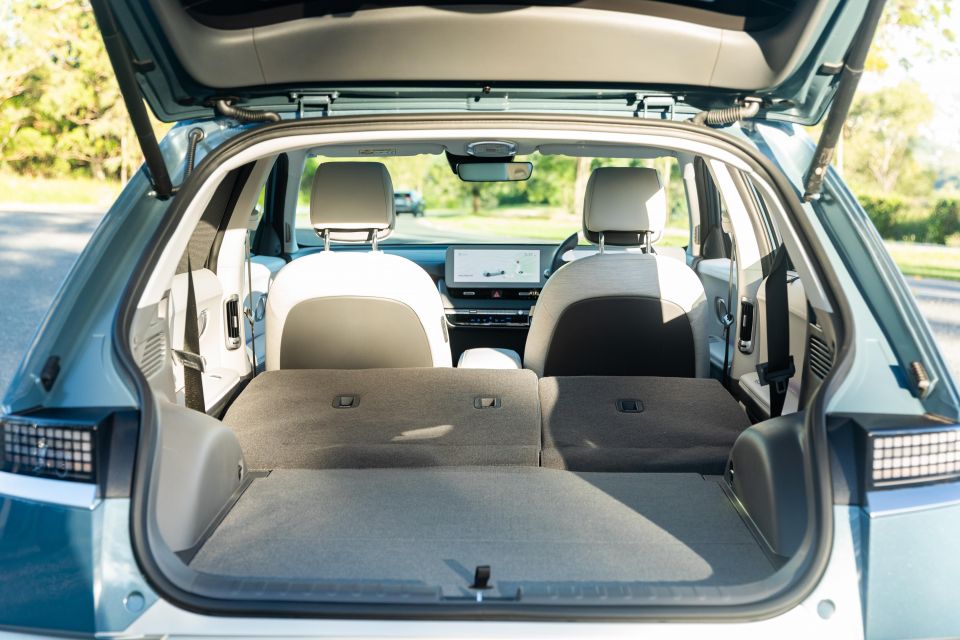
Headroom doesn’t fare quite as well – my hair was touching the roof, but you can at least adjust the rake of the seat.
The rear air vents are positioned at the rear of the B-pillars, while there are USB-A outlets at the rear of the centre console. The front passenger seat also includes buttons on the side, allowing rear seat passengers to easily move it, while there’s the standard fold-down rear armrest with cupholders.
For such a large car, boot space is only so-so on account of the steeply-raked tailgate, and using the cargo blind eats into this further. Hyundai quotes a boot storage capacity of 527L, while there’s also a small (57L) storage area under the bonnet that can support up to 25kg of weight.
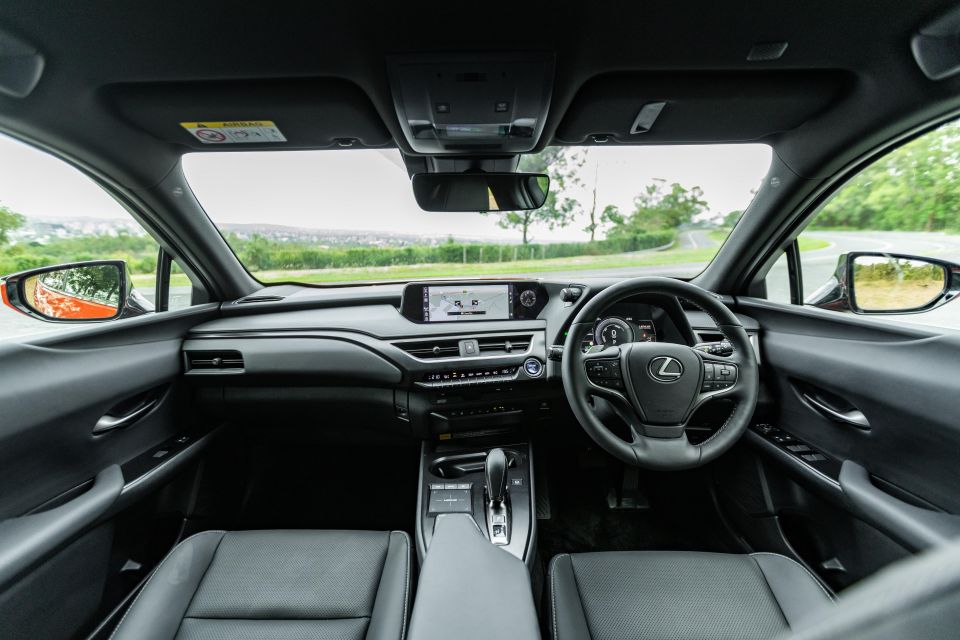
UX300e
The UX300e’s interior is largely identical to petrol-powered UX’s. While that means it’s not as exciting as the Ioniq 5’s cabin, there’s still a lot to like here. That includes solid build quality, soft-touch materials, and a straightforward dash with physical buttons.
The black colourway of our tester is rather funereal. While we’re happy there’s no piano black trim to be found, the UX’s cabin could do with some contrast. The door cards, for example, are almost entirely covered in soft-touch plastic up front and yet they look like bland, injection-moulded plastic and feature two different types of grained black material.
The available white leather upholstery of the UX300e Luxury brightens things up, while stepping up to the Sports Luxury yields a range of colourways including an intriguing one with two-tone white/grey seats and a bright blue dash top.
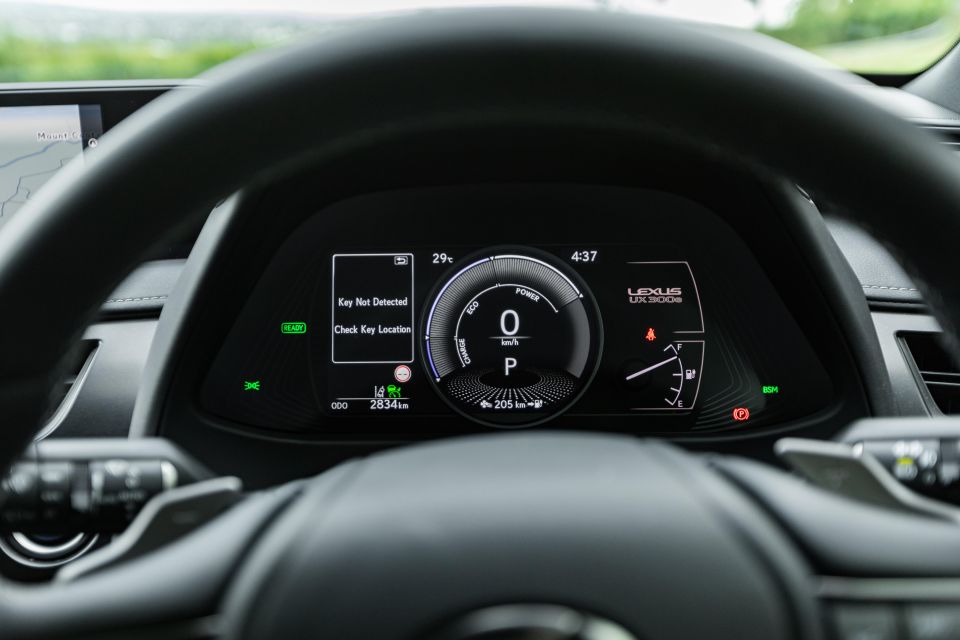
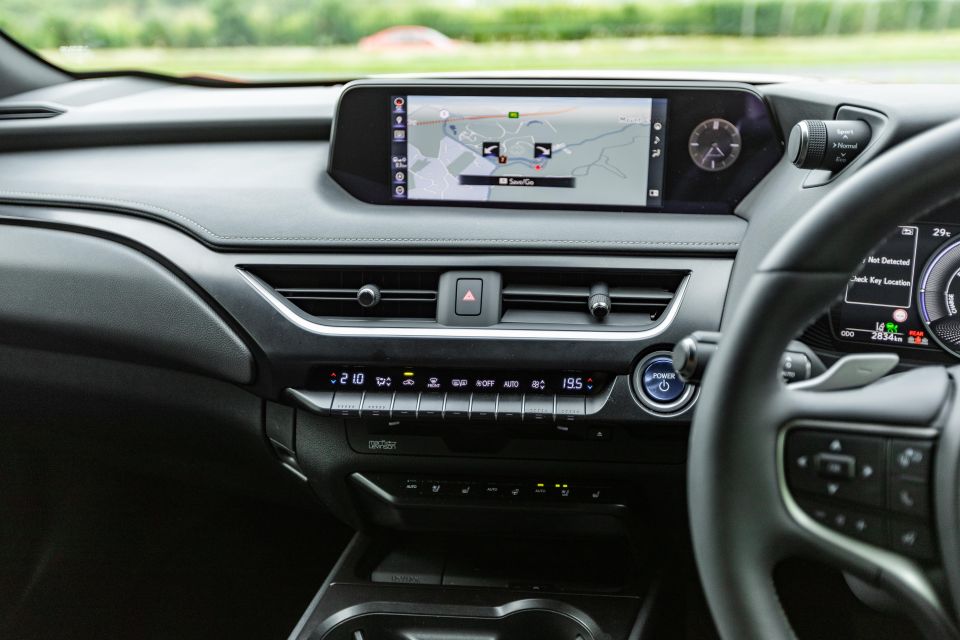
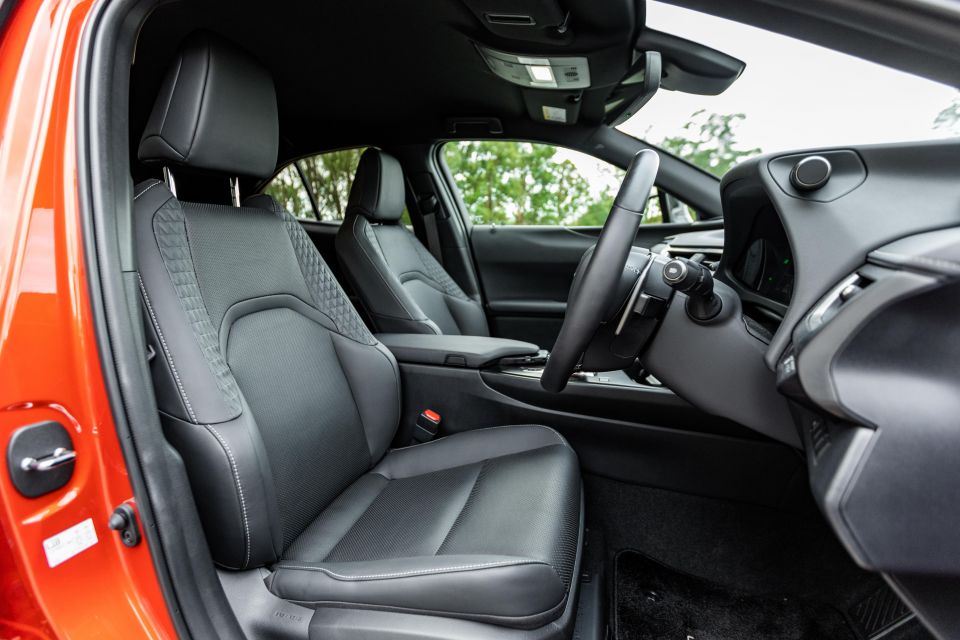
The instrument cluster is effectively the same as that in the UX250h hybrid, with a 7.0-inch colour screen to one side, a digital speedometer in the centre with a remaining range readout below, and two dials to the side. Amusingly, the Lexus’ charge dial looks the same as the fuel economy dial in the UX250h, with the petrol bowser pictogram’s pump replaced with a charge cable.
The dash design is a bit fussy and nobody I asked seems to like the placement of the drive mode selector on the instrument cluster hood, but there’s not much to object to here. That is, except for the infotainment system.
The UX was one of the last Lexus models launched without touchscreen functionality. That forces you to rely on the trackpad. We’ve all been griping about Lexus’ Remote Touch since it was first released as it’s awkward to use and inferior to, say, BMW’s iDrive rotary dial controller. When stationary, it’s tolerable; on the run, it’s not.
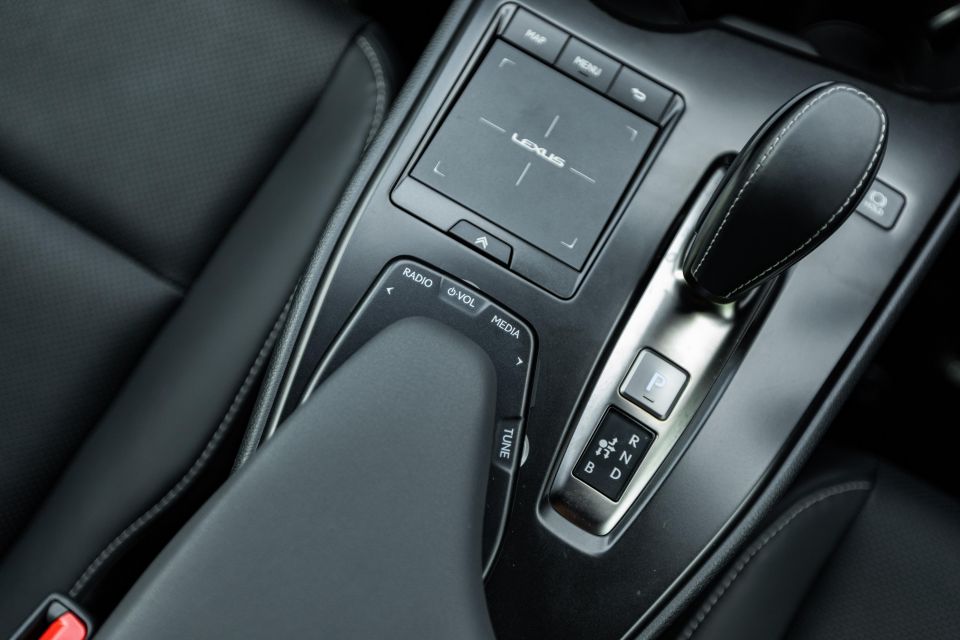
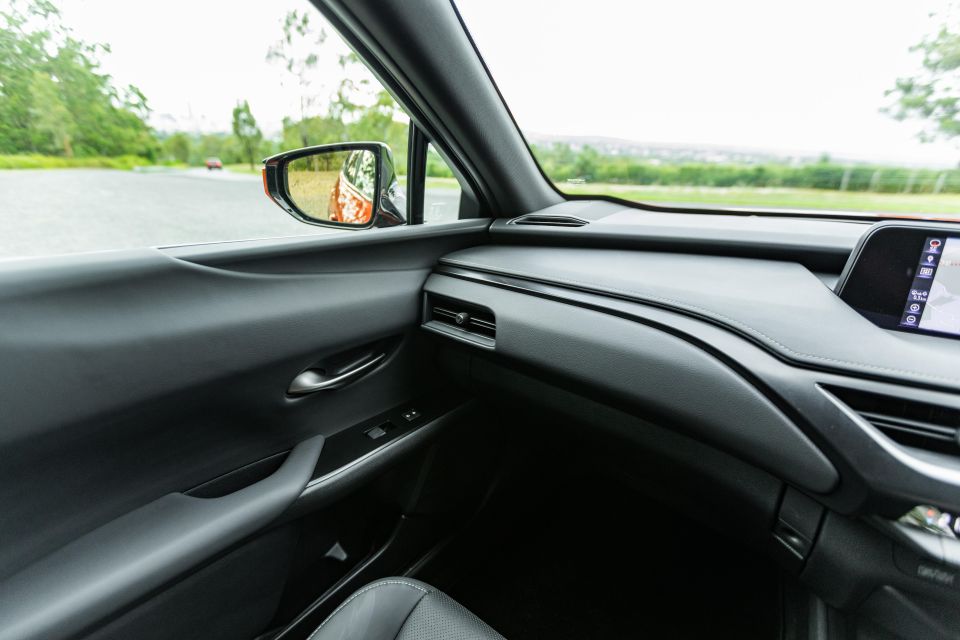
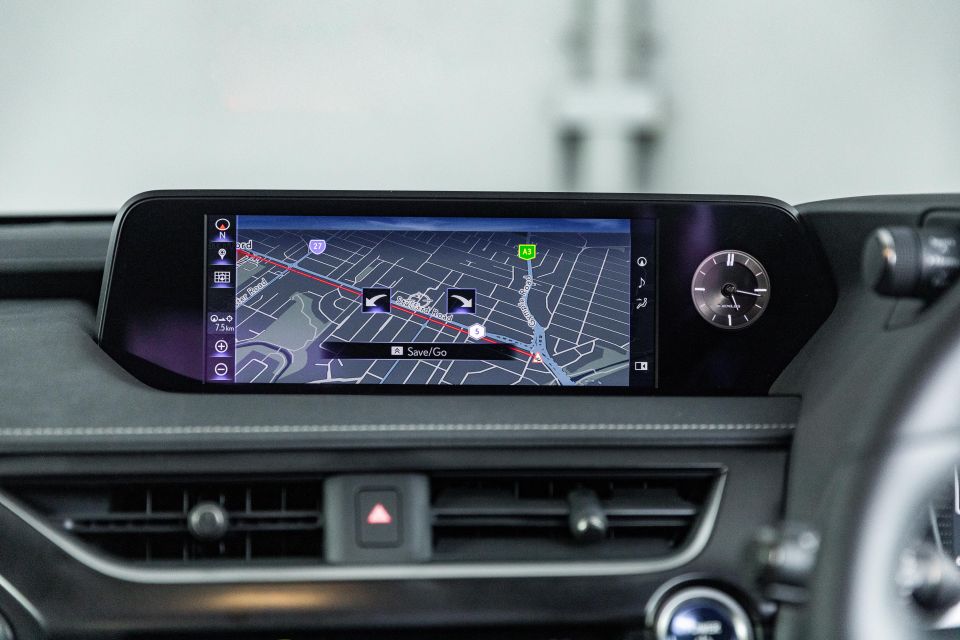
About the only way the Lexus’ infotainment system is superior to the Hyundai’s is in its full-screen application of Android Auto. Not that that’s much of a win for the Lexus – using smartphone mirroring without a touchscreen is an exercise in sheer frustration.
The rest of the UX’s cabin is more thoughtfully designed. There are actual buttons for seat heating and ventilation, and the car will remember your settings upon start-up. And while the Ioniq 5’s Bose sound system is good, the UX’s Mark Levinson unit absolutely puts it in the shade.
Step into the rear, and it feels noticeably darker and tighter in the UX. The belt line slopes upwards, reducing visibility, while the car’s smaller exterior dimensions naturally translate into less space.
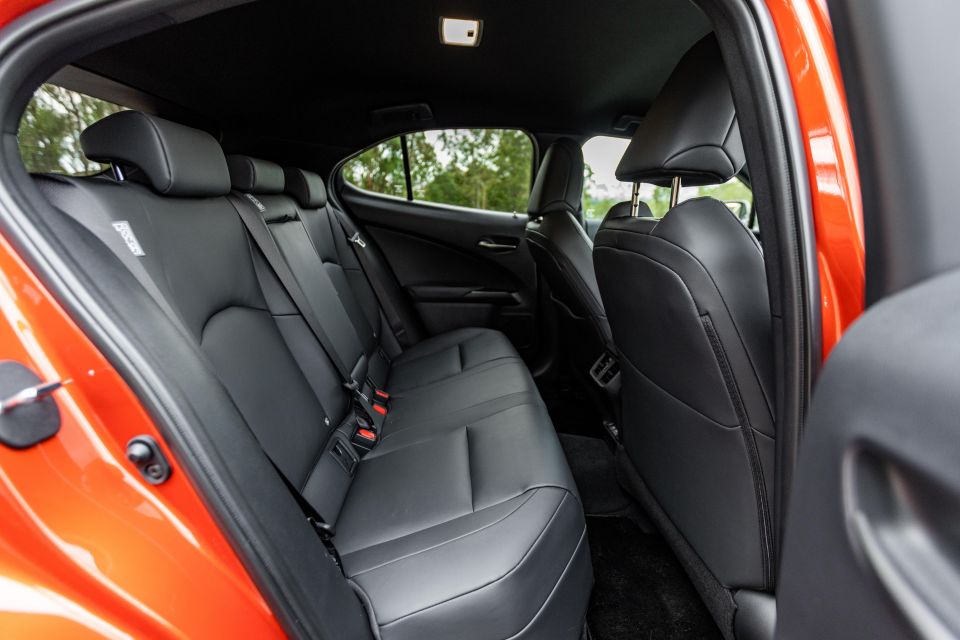
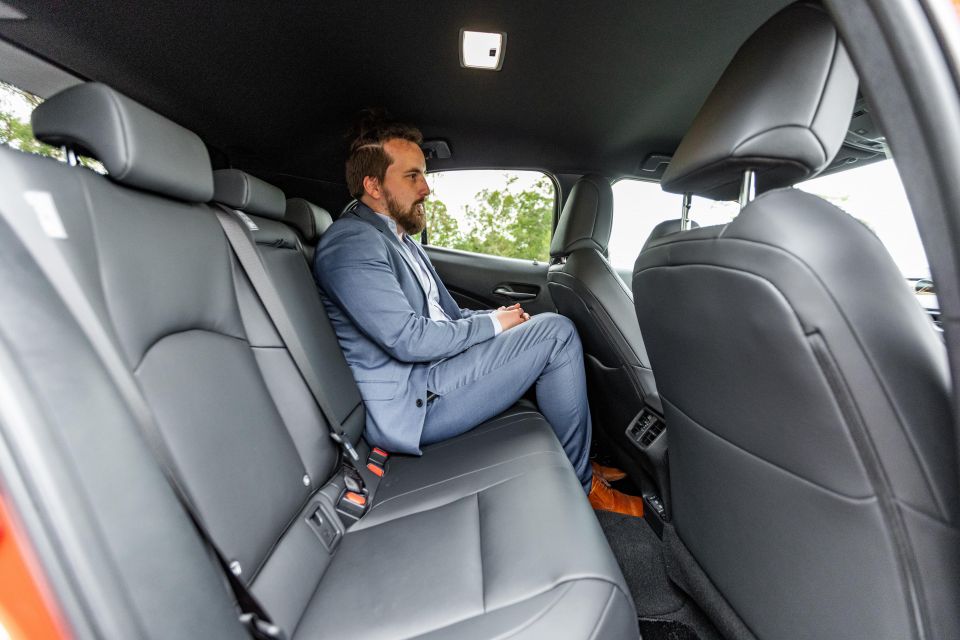
Even ingress and egress is compromised, with the UX’s rear door opening being surprisingly small. The door cards are also hard plastic apart from a soft-touch insert.
Where the UX suffers the most is its lack of toe room. If the front seats are at their lowest setting, toe room is some of the worst I’ve experienced in the second row of an SUV. There’s also a hump in front of the centre-rear seat, further eating into space.
There’s a fold-down centre armrest with cupholders, directional rear air vents, USB charging outlets and a map pocket behind the front passenger seat.
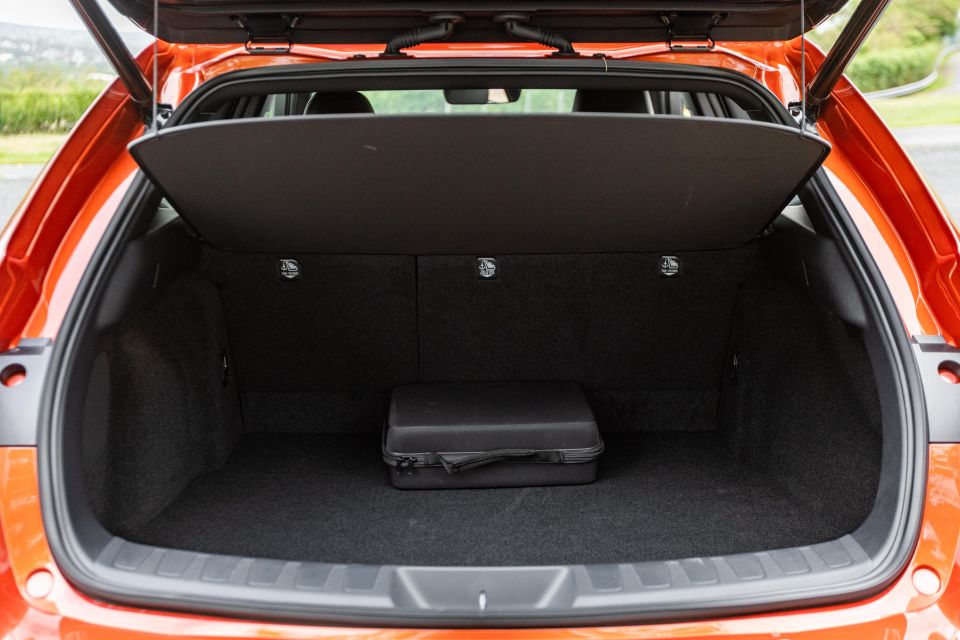
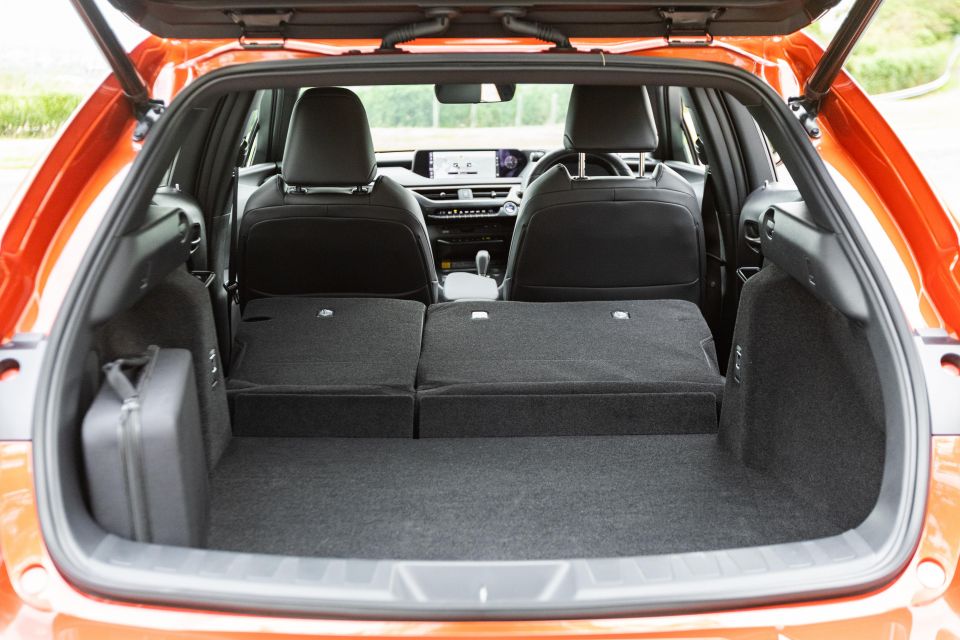
The boot is smaller than the Ioniq 5’s, with 314L of storage capacity – about as much as a Toyota Corolla hatchback. There’s no storage area under the bonnet.
Other interior gripes include a headliner that could be more tactile, cupholders that could be deeper, and no soft-touch material on either side of the centre console where your knee may make contact.
Something worth noting: the steering wheel voice prompt button only works with the core infotainment system, not smartphone mirroring. That’s flipped in the Hyundai, where it only works for smartphone mirroring.
| Hyundai Ioniq 5 | Lexus UX300e | |
|---|---|---|
| Length | 4635mm | 4495mm |
| Width | 1890mm | 1840mm |
| Height | 1605mm | 1525mm |
| Wheelbase | 3000mm | 2640mm |
| Boot | 527L | 314L |
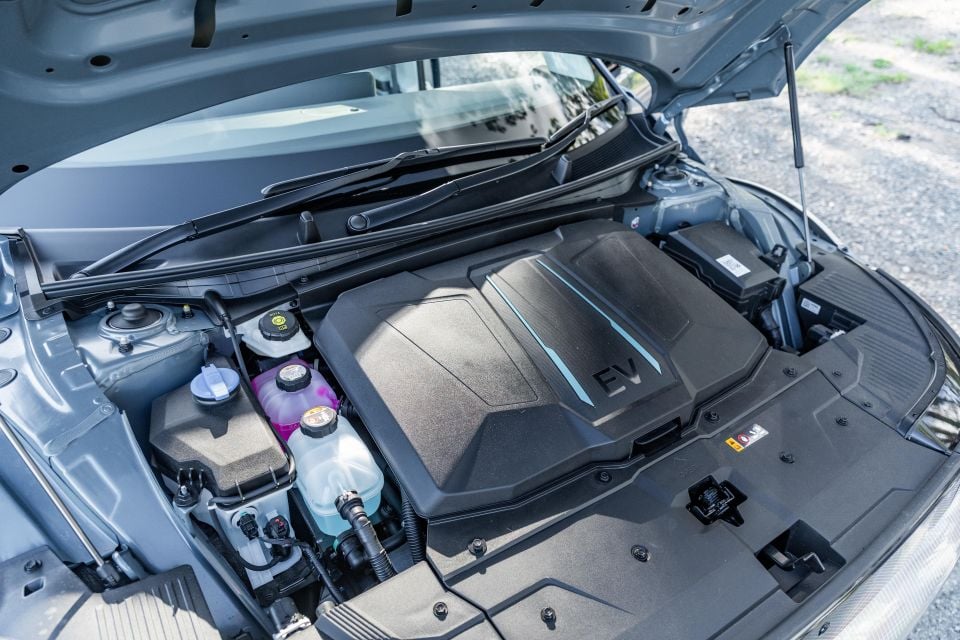
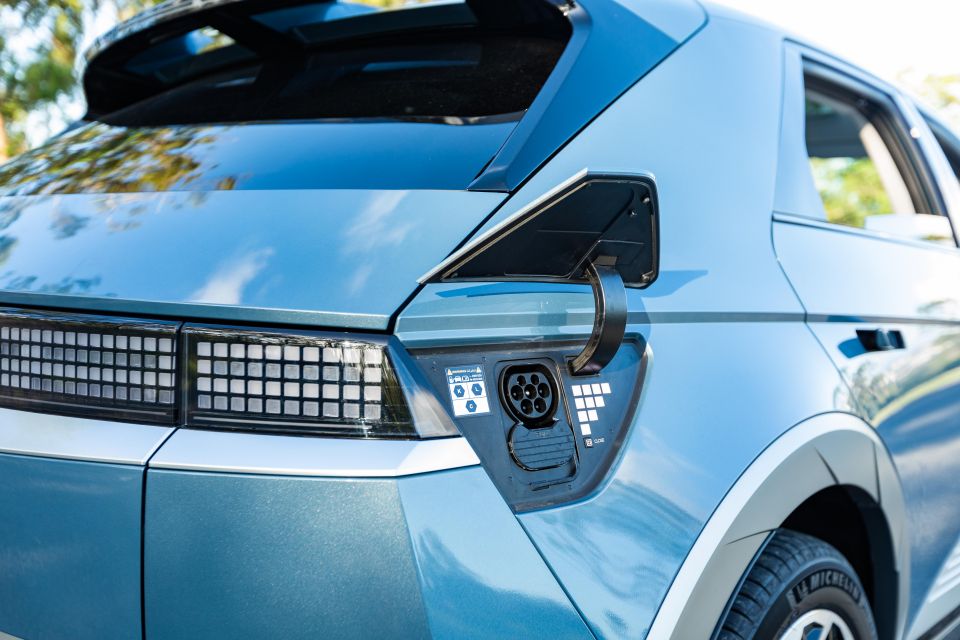
Ioniq 5
The Ioniq 5 has a single, rear-mounted electric motor with 160kW of power and 350Nm of torque, though a dual-motor all-wheel drive version is available with outputs of 225kW/605Nm. Both variants use a 72.6kWh lithium-ion battery.
Hyundai claims a 0-100km/h time of 7.4 seconds.
Thanks to its larger battery, the Ioniq 5 has the UX300e beat when it comes to range, boasting 451km of range on the more realistic WLTP test cycle.
It can be charged at up to 350kW on a DC charger. It’ll take 18 minutes to go from 10 to 80 per cent charge on a 350kW charger, or 69 minutes using a 50kW DC charger.
It’s not just a higher charging rate and better range that the Hyundai holds over the Lexus. The Ioniq 5 also features vehicle-to-load (V2L) capability, allowing you to charge appliances. The Hyundai also features a CCS2 charging port which, at least up here in Brisbane, is a lot easier to find a DC charger for than the Lexus’s CHAdeMO port.
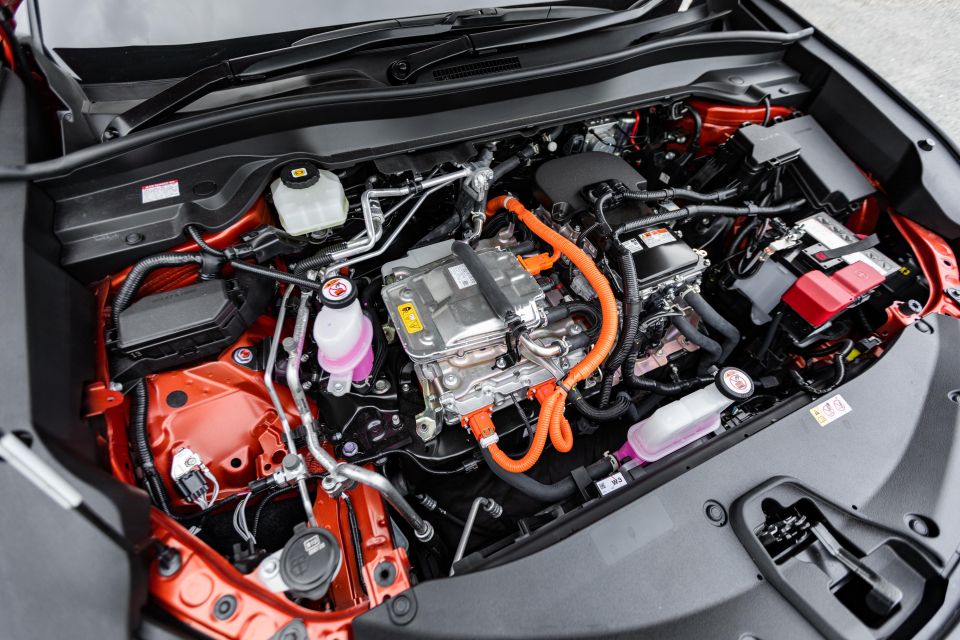
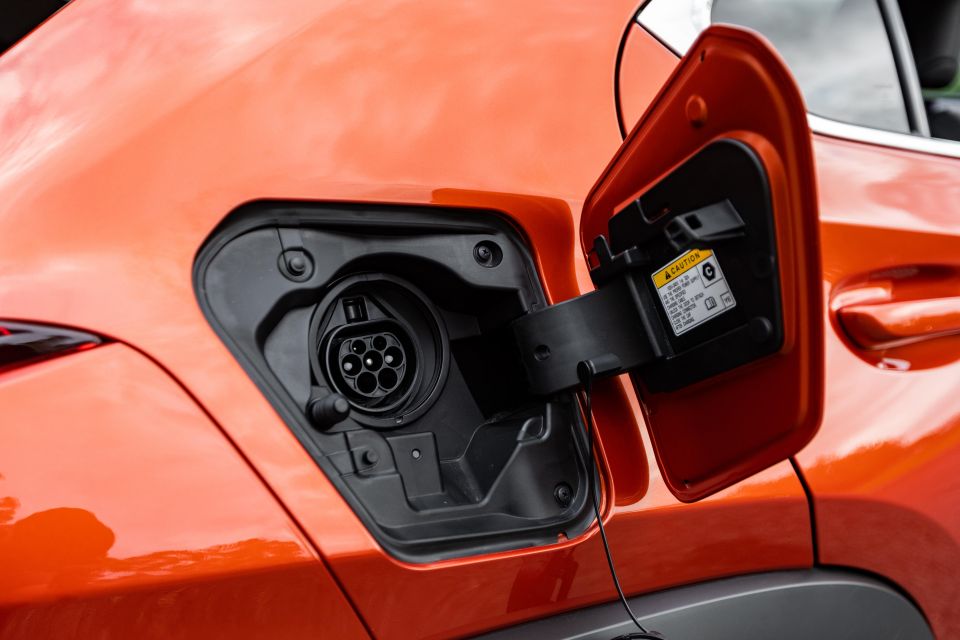
UX300e
The UX300e has a single, front-mounted electric motor producing 150kW of power and 300Nm of torque. Lexus claims a 0-100km/h time of 7.5 seconds. It uses a 54.3kWh lithium-ion battery.
The Lexus offers a claimed 360km of range, but on the more lenient NEDC cycle. It can be charged at a rate of up to 50kW on a DC charger, disappointing for a luxury brand EV in 2022.
All up, it takes 80 minutes to go from empty to 100 per cent on a 50kW or higher DC charger, or 50 minutes to charge to 75 per cent.
Lexus claws back a little bit of ground with its after-sales package. UX300e buyers receive a professionally-installed AC home charger from JetCharge as part of their purchase, capable of fully charging the vehicle’s battery from empty in 6.5 hours.
It also comes with three years of complimentary access to ChargeFox’s high-speed DC charge network, one of the nation’s largest with over 1400 outlets and 770 charge stations across the country.
| Hyundai Ioniq 5 | Lexus UX300e | |
|---|---|---|
| Weight | 2020kg (tare) | 1840kg (kerb) |
| Front suspension | MacPherson strut | MacPherson strut |
| Rear suspension | Multi-link | Multi-link |
| Dampers | Passive | Passive |
| Steering | Electro-mechanical | Electro-mechanical |
| Front brakes | Ventilated disc | Ventilated disc |
| Rear brakes | Ventilated disc | Ventilated disc |
| Ground clearance | 160mm | 141mm |
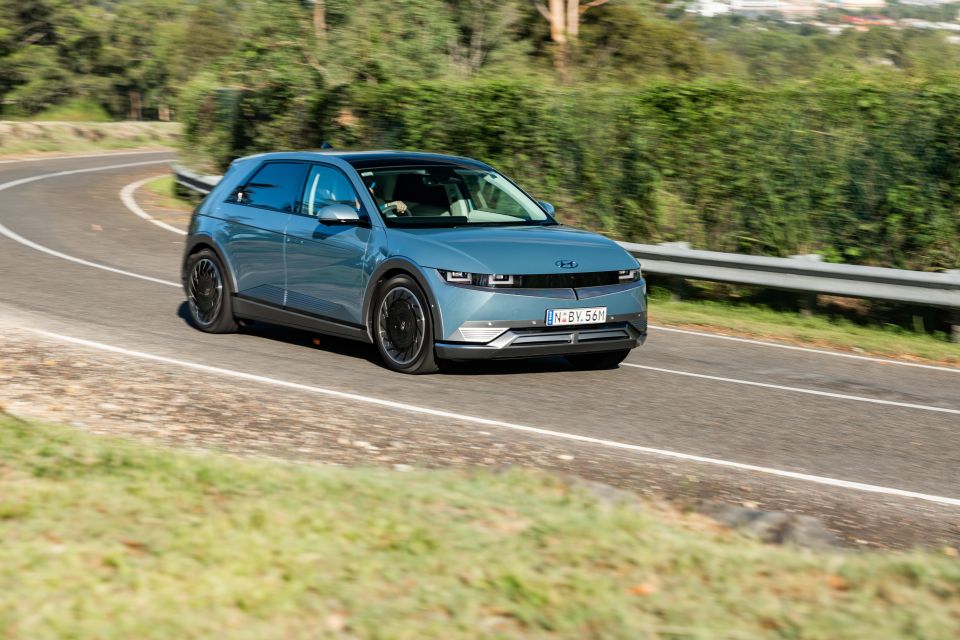
Ioniq 5
The Hyundai is a largely polished affair on the road, with one exception.
As we’ve noted before, body control is unimpressive at high speeds on country roads. It takes a little too long to settle on an undulating road and has a tendency to wallow. This wallowy feeling is largely banished in other driving environments.
On a smoother highway, the Ioniq 5 feels more in its element. The cabin is kept largely free from wind and tyre noise and the ride is more pliant than in the Lexus. You’ll hear a little bit of tyre roar on coarser-chip roads, but overall the Hyundai’s cabin is quite quiet.
Ride quality is also hard to fault overall. It’s not quite as cushy as the Lexus, but it’s more consistently comfortable.
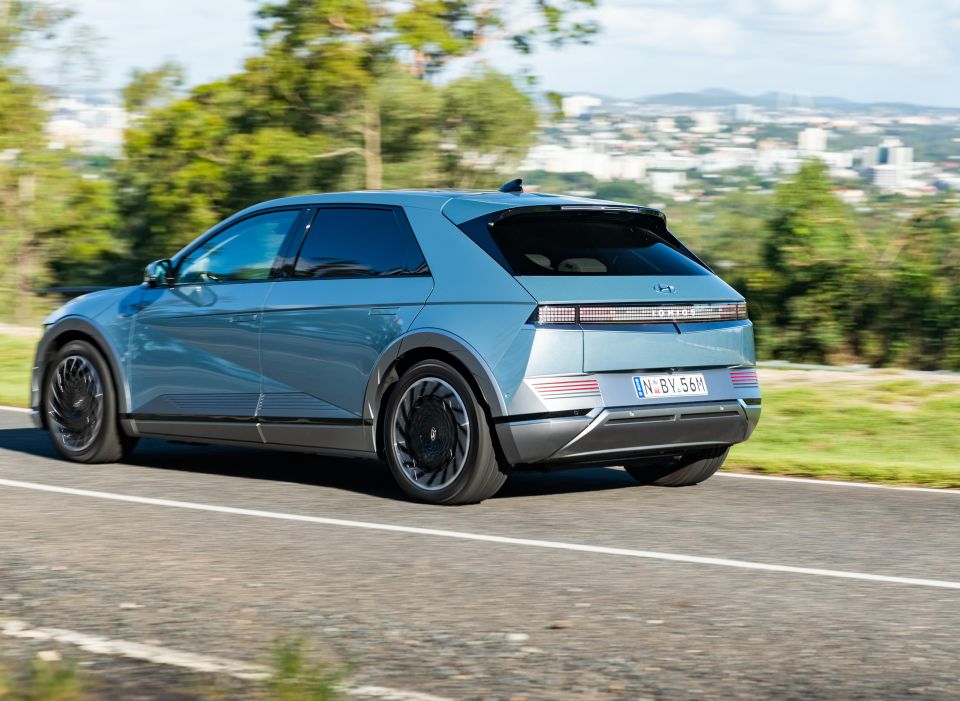
On a winding road at lower speeds, the Ioniq 5 is competent if unexciting. You feel its size, particularly with its long wheelbase, but it can tackle corners with competence. It’s in this more spirited driving where I personally prefer the balance of rear-wheel drive over the front-wheel drive UX.
Despite the immediate rush of torque, the Ioniq 5 feels stable and secure. With the Ioniq 5’s ample reserves of torque, there’s really no reason to use Sport mode.
The steering is somewhat lacking in road feel but there’s a decent weight to it. What you will feel through the steering are the Ioniq 5’s lane support systems.
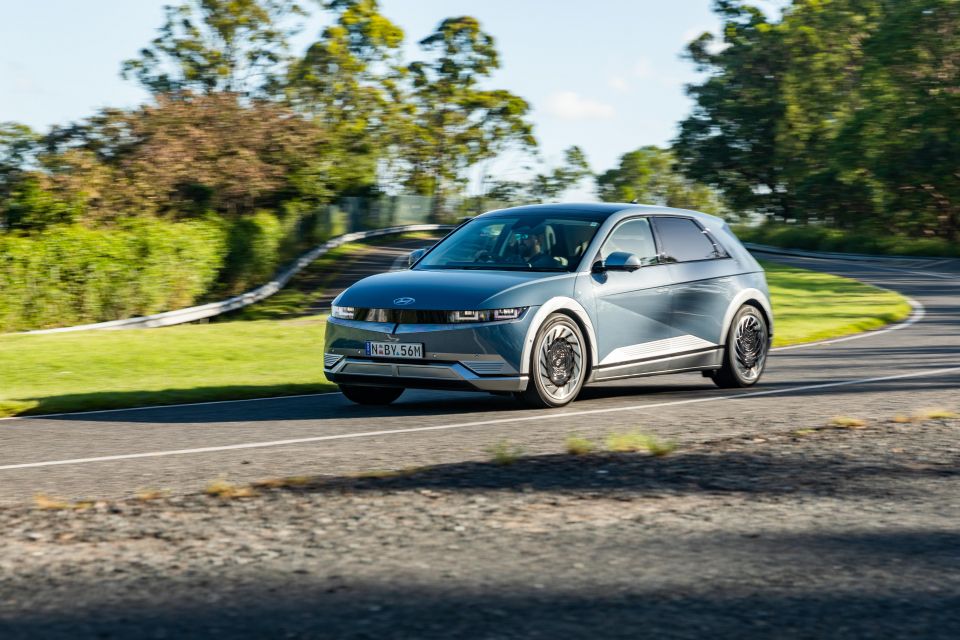

The Ioniq 5’s lane-keep assist is more intrusive than the Lexus’, tugging at the wheel in curves. The lane-following assist inspires more confidence than the corresponding system in the Lexus, and this feature works preternaturally well in most Hyundai products. It makes the Hyundai the choice for long-distance driving.
You can choose between Normal, Eco and Sport modes, while the paddle shifters behind the wheel can be used to adjust the level of regenerative braking. In its strongest setting, you can drive without touching the brake pedal all that often.
The price to pay for a more spacious cabin in the Ioniq 5 is reduced manoeuvrability compared with the smaller UX. Manoeuvring in and out of tight spaces, the Ioniq 5’s long wheelbase becomes somewhat of a liability.
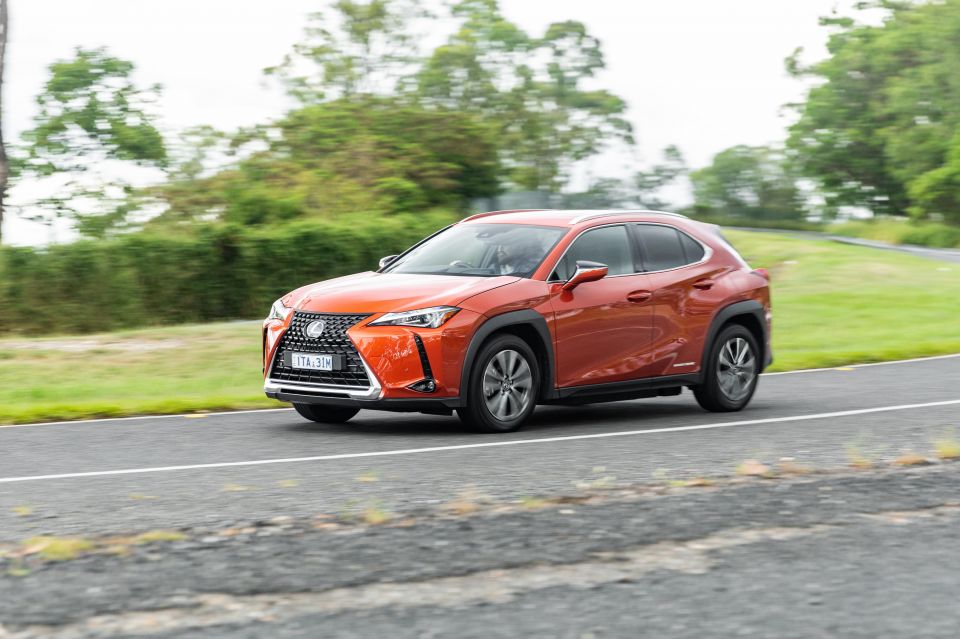
UX300e
Whatever you do, don’t be too heavy on the throttle in the Lexus.
It’s a peppy little thing, but the instant torque from its electric motor will have you chirping the tyres if you’re not careful with your right foot. You’ll see the stability control light flickering manically not just from a standing start, but even in corners. Not driven judiciously, it feels squirrelly.
Part of the blame could be attributed to the Dunlop Enasave tyres. The sound of these tyres also intrudes into the UX’s otherwise serene cabin at highway speeds. The good thing is you don’t need to push the UX to get the most out of it, as it’s got more than enough power to get out of its own way.
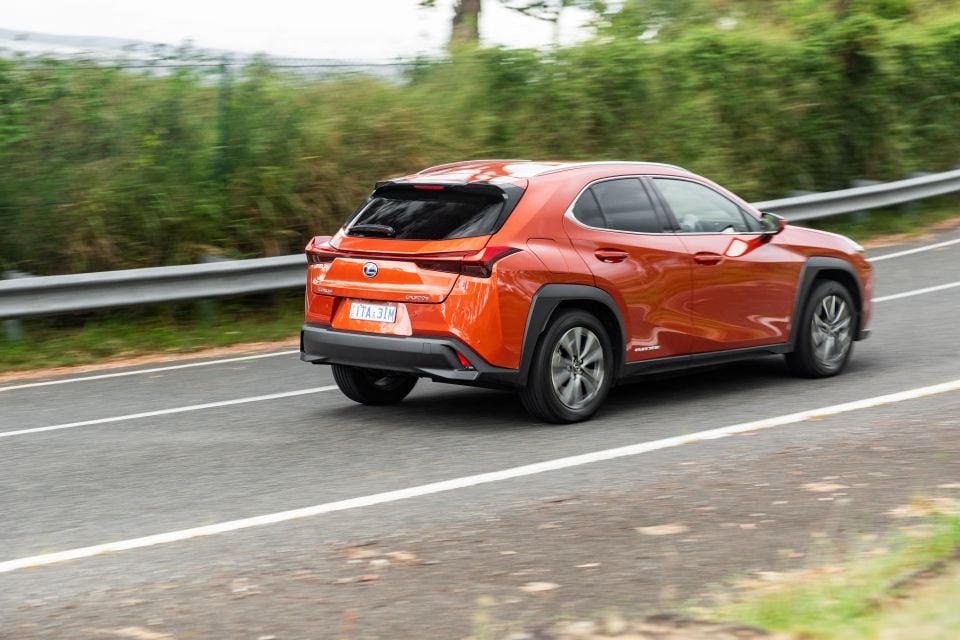
The UX’s suspension feels soft, yet the ride isn’t completely cushy. Expansion joints and the like, particularly at highway speeds, aren’t smothered by the suspension. That same feeling of a lack of body control on undulating rural roads can also be felt in the UX.
We expected the UX to be more nimble and fun to drive, given its competent TNGA underpinnings and smaller size. But the addition of a heavy battery has dulled the UX’s responses, and the Lexus lacks the balance and poise of the even heavier Hyundai.
Like the Hyundai, there’s also a lack of road feel through the steering, and the Lexus’ tiller feels even more light and numb.
The UX’s lane-tracing assist needs to make more little adjustments to stay centred in its lane on the highway, but overall both it and the lane-keep assist work well.
You can use the paddle shifters to adjust the level of regenerative braking, provided you’ve put the shifter in B. Like the Ioniq 5, there’s the potential for one-pedal driving once you put it in its strongest setting.
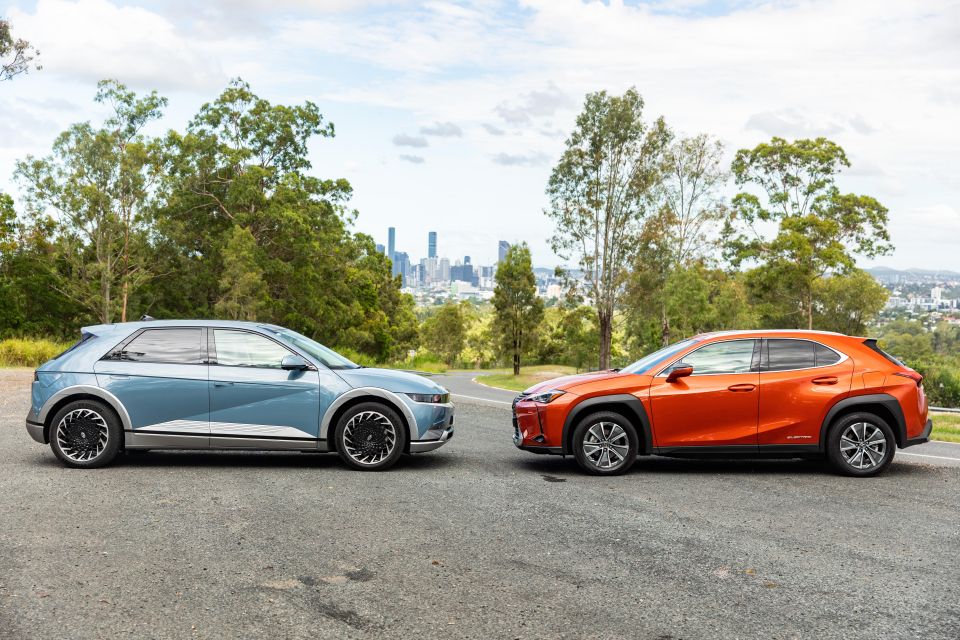
We took the Ioniq 5 and UX300e on an identical 50km route, comprising inner-city, suburban and highway driving, with both cars on an intermediate level of regenerative braking.
Both saw reductions of 42km from their range metres, with the Ioniq 5 recording energy consumption of 16kWh/100km and the UX300e 15.9kWh/100km.
Over the course of several days with each car, the Hyundai’s energy consumption increased to 18.6kWh/100km while the Lexus reached 17.3kWh/100km.
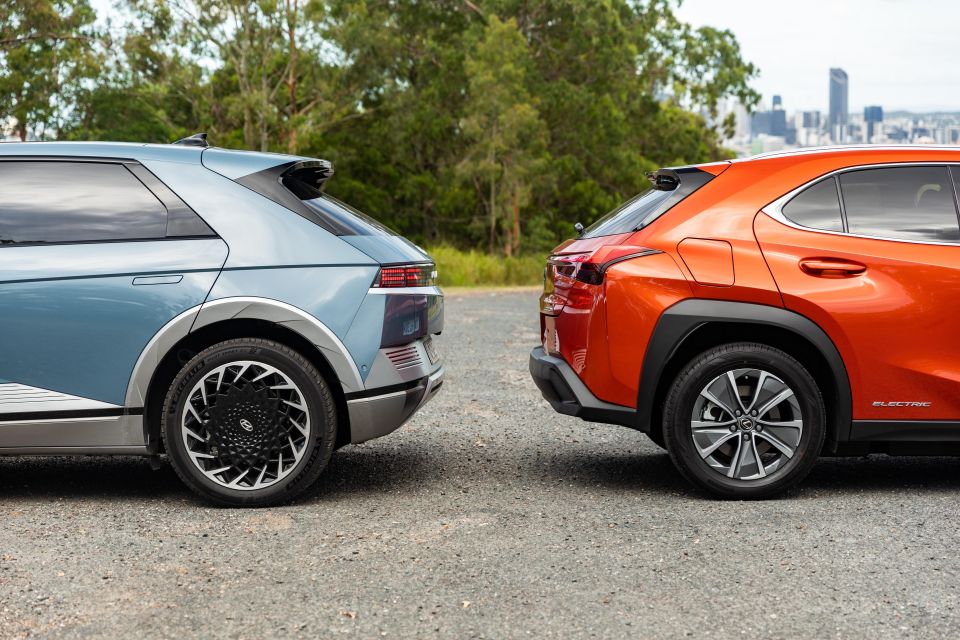
Both cars are backed by a five-year, unlimited-kilometre warranty, and both cars require servicing every 12 months or 15,000km.
They both also include separate battery warranties: eight years/160,000km in the Hyundai, 10 years/160,000km in the Lexus.
The first five services are capped at $220 in the Hyundai (apart from the fourth service, which is $804) and $295 each in the Lexus.
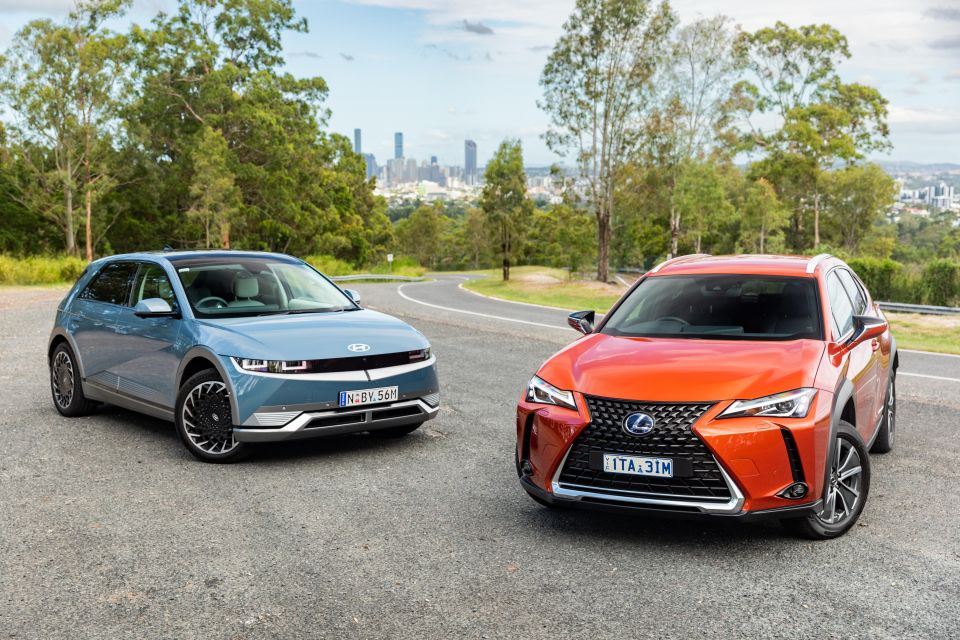
To choose the Lexus UX300e over the Hyundai Ioniq 5 is like having Frank Lloyd Wright or Le Corbusier offering to design you a house but you opt to just choose one off the plan.
The UX300e is naturally going to be compromised by its origins in an internal combustion engine vehicle, prohibiting it from having the same refreshing, clean-sheet approach to design that the Ioniq 5 has.
That’s not to say it’s a bad car, however. It’s easier to steer around town, owing to its smaller dimensions. The after-sales package is better with its three years of free DC charging and supplied AC home charging station, and it has a better sound system.
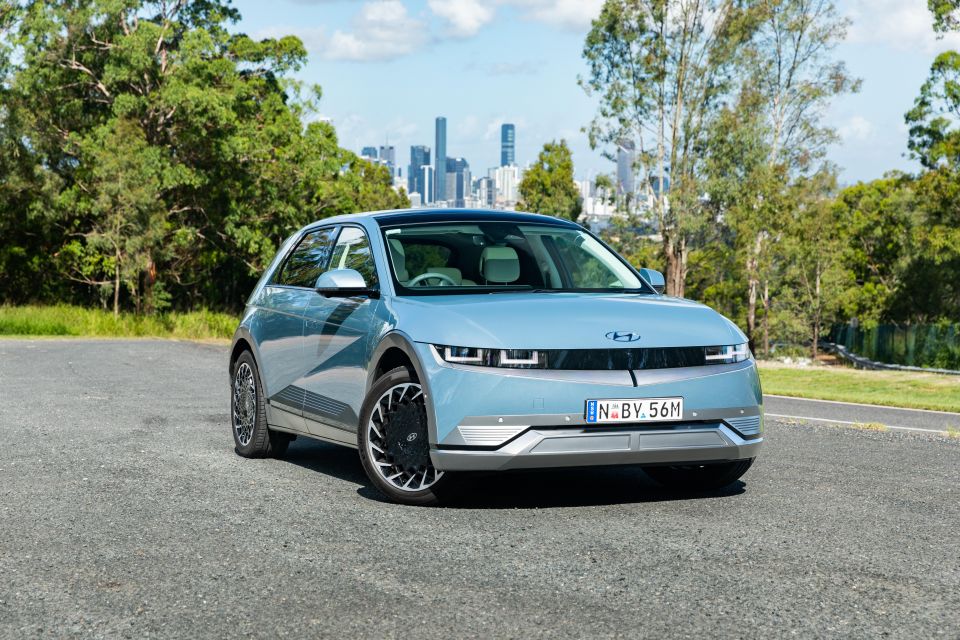
There’s a clear winner in this comparison, though: the Hyundai Ioniq 5.
It’s fundamentally a better EV, with more range and better charging capability including V2L support.
The Hyundai is also quieter, better packaged, more enjoyable to drive, and gets power to the road more effectively. It has more showroom appeal, and its interior features material quality on par with the Lexus and an infotainment system that puts it to shame.
It’s absolutely what we would pick. Now, about actually getting one…
MORE: Everything Hyundai Ioniq 5 MORE: Everything Lexus UX
Share your thoughts with us in the comments below!
William Stopford is an automotive journalist with a passion for mainstream cars, automotive history and overseas auto markets.
Share your thoughts and write a review of a car you own and get featured on CarExpert.


CarExpert.com.au
6 Hours Ago


Damion Smy
20 Hours Ago


Damion Smy
23 Hours Ago


Damion Smy
1 Day Ago


Damion Smy
1 Day Ago


Damion Smy
1 Day Ago